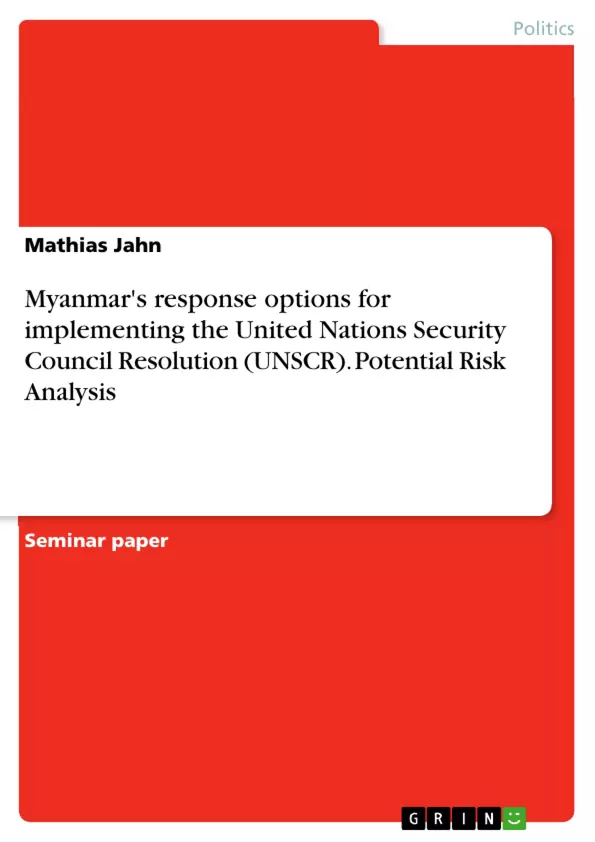The analysis of three response options to UNSCR 2669 suggests that it will coincide with the Military Caretaker Government's aim to retain its power posture with the mainstream scenario ("Stalling Strategy & One-Party Rule"). Furthermore, though resulting in a protracted civil war, the regime's past successful economic stabilization efforts will contribute to the recovery of MMR's macro-/ microeconomics, indicating a shift of political risk from a negative to a neutral zone by Q4/2023 onwards.
Inhaltsverzeichnis (Table of Contents)
- SCENARIO TREE
- EXECUTIVE SUMMARY
- CONTEXTUAL PRIMER OF DEVELOPMENTS
- MAINSTREAM SCENARIO
- CREDIBLE ALTERNATIVE
- OUTLIER SCENARIO
- ASSESSMENT OF POLITICAL RISK FOR BUSINESSES
Zielsetzung und Themenschwerpunkte (Objectives and Key Themes)
This analysis aims to provide a comprehensive evaluation of Myanmar's response options for implementing the United Nations Security Council resolution (UNSCR) 2669, through a scenario-based Political Risk Analysis for Business Companies till 2024.
- Analysis of Myanmar's potential responses to UNSCR 2669
- Assessment of political risk for businesses operating in Myanmar
- Examination of Myanmar's economic stability and its impact on political risk
- Evaluation of the role of international actors, including ASEAN and the UN, in the Myanmar crisis
- Exploring the potential impact of the UNSCR on Myanmar's political landscape and civil war dynamics
Zusammenfassung der Kapitel (Chapter Summaries)
- SCENARIO TREE: This chapter presents a detailed breakdown of three potential scenarios for Myanmar's response to UNSCR 2669: the mainstream scenario (high probability), the credible alternative (medium probability), and the outlier scenario (low probability). Each scenario outlines key events and their potential impact on the political and economic landscape of Myanmar.
- EXECUTIVE SUMMARY: This chapter provides a concise overview of the analysis, highlighting the key findings and conclusions drawn from the three scenarios. It emphasizes the high probability of the mainstream scenario, which suggests that the military regime will likely continue its stalling tactics and pursue a one-party rule.
- CONTEXTUAL PRIMER OF DEVELOPMENTS: This chapter offers a background on the political and humanitarian crisis in Myanmar, including the role of ASEAN and the UN, and the impact of the military coup on the country's stability. It provides a context for understanding the current situation and the significance of UNSCR 2669.
- MAINSTREAM SCENARIO: This chapter elaborates on the most likely scenario, where the military regime (MCG) will continue to stall the implementation of UNSCR 2669 and its associated confidence-building measures (CBMs) while maintaining a state of emergency. It describes how the MCG will attempt to solidify its power through sham elections and continue the violence against opposition forces, with support from China and Russia.
- CREDIBLE ALTERNATIVE: This chapter explores a scenario where the MCG openly defies UNSCR 2669 by escalating violence and provoking international intervention. The chapter describes how this defiant approach could trigger a wider civil war, leading to an international refugee crisis and potentially a UN-mandated military intervention.
- OUTLIER SCENARIO: This chapter examines a less likely scenario where the MCG complies with UNSCR 2669 and negotiates a power-sharing deal with the opposition. This scenario highlights the potential for a peaceful resolution of the conflict, but emphasizes that this outcome is less probable given the MCG's past behavior and its reliance on China and Russia.
Schlüsselwörter (Keywords)
The core focus of this Political Risk Analysis is on Myanmar's response to UNSCR 2669, its impact on business operations, and the role of international actors. Key themes include: political risk, Myanmar's military regime (MCG), confidence-building measures (CBMs), civil war, international sanctions, ASEAN, UN Security Council (UNSC), economic stability, and business strategies.
- Quote paper
- Mathias Jahn (Author), 2023, Myanmar's response options for implementing the United Nations Security Council Resolution (UNSCR). Potential Risk Analysis, Munich, GRIN Verlag, https://www.hausarbeiten.de/document/1336026


